Why the People’s Republic of China Is Not Responsible for America’s Drug Problem
The FBN Myth On the “War on Drugs” Crusade
There is understandably a growing indignation over the opioid crisis that has become too large to ignore at this point. In many towns and metropolises, tent cities can be found taking up an ever-larger portion of city space. This is occurring throughout the once-affluent western world. The homeless, in such places as the notorious East Hastings of Vancouver, British Columbia, has grown to hundreds upon thousands living on the streets, the greater majority on opioids or crystal meth.
The problem has now entered West Hastings as well. Areas in Victoria, also in British Columbia, are among the worst cases in Canada of municipalities being taken over by these tent cities rampant with drug addiction, prostitution and crime. Canada, a country that has never really had hard-core ghettoes, has been increasingly taken over by the tent-city phenomenon over the last decade.
Note these pictures cannot do justice to the immense size of these tent cities which in the case of Hastings spans about 20+ blocks of what has become not just people living on the street but in abandoned dilapidated buildings. In other words, most of the businesses have understandably left these areas and no business wishes to take their place. Thus, the city is left with an ever-expanding zone of abandoned buildings. In these buildings are prostitution and drug laboratories amongst other things.[1] The businesses that do remain or take-up shop in these areas are those that cater to the tent city economy, for example pawn shops that ask no questions in dealing with the goods they are presented with.
I have walked through East and West Hastings a number of times and have seen how quickly the situation has worsened over the years, having once lived in Vancouver I visit the city often since I still have family there. It is common to see people living on the street in these conditions “frozen” in time, often standing but with the upper body completely hunched over or leaning sideways, a side-effect from one of the street drugs. They can stay in such a position for hours. Or those who have such terrible health that their hair is falling out and it looks like their skin is bubbling over, likely an effect from crystal meth. Truly, there are sections of East Hastings that look like they are straight out of a Goya painting. And then there are the saddest cases, of those who are covered with bruises and scars, unable to defend themselves from their daily onslaught of attackers fighting for scraps.
I remember twenty years ago, as a young adult, that we were taught not to make any judgement on any of this. In other words, that we shouldn’t judge their “decision” to live on the street and do drugs. Rather, that we should treat them like any other human being we encountered, even if they were literally walking around like an actual zombie and mumbling incoherency. We were taught to sit at a park bench in the middle of filth, and not turn up our noses at it, but to accept this as the chosen ecosystem of certain people and we simply needed to accept this.
For many years, the Vancouver and Victoria municipalities have treated this crisis of homelessness and drug addiction as if it were in fact - not an actual problem. In other words, the city took the stance, and many mushy liberals with them for the past ten years and more, that it was simply a matter of providing food and “safe injection sites” and even “free drugs” so they would not steal and commit crime (in theory), and that this approach was going to somehow decrease the number of homeless living on the street, who mostly suffer from drug addiction.
I remember when the safe injection sites were first being promoted in Vancouver over 17 years ago, the “theory” was that those who were suffering from heroin addiction could safely administer their drug at safe injection sites during their work break. Methadone, a synthetic opioid, was being sold at the time as a way to wean off of heroin and was available in the form of a tablet, oral solution or injectable liquid. It was thought that with Methadone, people with heroin dependence should have no problem getting their “fix” and working full-time. However, after over 17 years it is clear that this theory is a complete failure. Heroin addiction has skyrocketed since and those on Methadone simply got addicted to Methadone. The greater majority of opioid addicts are not able to keep a full-time job for very long and yes, very predictably, they end up on the street.
You would think such cities as Vancouver would have gotten a clue since then, however, rather they have only increased their support for such tent cities. Taxpayer money goes to cleaning Hastings Street daily, during the summer, of the filth that accrues from just one day of tent city traffic and activities. Every morning food and even “free drugs” are offered to the tent city folk, paid for by the taxpayer. Not only this, but areas like Victoria have even encouraged homeless people from across the country to come live in their tent cities. CTV News reported that the Victoria, Vancouver Island tent city in 2016 costed $1.6 million of taxpayer money every year. The cost is most certainly a great deal higher today.
The problem has reached such catastrophic levels that even the mushy liberals are starting to squirm uncomfortably. Clearly, these people who advocated the “right” for homeless people to live in their East Hastings’ ecosystem are starting to have issues if the better parts of town are also going to be implicated. In other words, they were fine with it as long as such people were relegated to a designated part of town, but with the threat of this ecosystem becoming the dominant ecosystem, they are now becoming more critical about the “problem” of the tent cities. And who is to blame? Well, the People’s Republic of China (PRC) of course (as with seemingly everything wrong with our collapsing society)….as well as Mexico, are blamed as the source for this problem for those who have taken all but two seconds to think about the matter. Even those who were advocates of “safe injection sites” for heroin users years ago are now getting on the bandwagon of blaming “communist China” for the situation they find themselves in today, funny how we never seem to want to take any responsibility in such matters and have readily agreed to beating a straw-man that has been conveniently placed in front of us. Anything but admit to ourselves the far uglier truth.
I have thus far spoken about the Canadian situation since it is the one I am most familiar with, however, I think that this also speaks volumes as to how far this opioid crisis has blown up such that it is no longer relegated to just the “dirty” American, British, French ghettoes etc. but has since entered suburbia and what are supposed to be among the most beautiful and peaceful cities in the world, including Vancouver and Victoria. In other words, the opioid epidemic has become ubiquitous. And most westerners know someone personally, or via a second-degree acquaintance who has died from an opioid overdose or has had their life destroyed by opioid or methamphetamine addiction.
If we truly care about the welfare of these people living in tent cities, and thus suffering from drug addiction, we need to acknowledge that none of this was an actual “choice”, a romantic rejection of “sell-out white collar cubicle living” and somehow a political statement of empowerment and freedom.
Let’s not kid ourselves here. If you are not economically empowered (i.e. can’t easily exit tent-city life) and are suffering from a drug addiction, you do not have the “freedom” to choose to do something else with your life, and as we see the pattern formation throughout the decades, most who end up on the street with drug addictions, will die from preventable health issues or drug overdose. To act like this is somehow a dignified and empowered way of living is in fact to completely abandon these people from the support they need to truly become sovereign beings. It is also completely avoiding a much more serious problem - the fact that such an outcome has been designed for that very effect.
This is what Harari speaks of when he discusses the “problem of the useless eaters.” Those, like Harari, who see themselves as at the helm of societal policy see the opioid crisis in a very different light. To them, this is how the “useless” and the “weak” can contribute to their society and at the same time address the so-called “overpopulation problem,” by effectively making up a consumer economy that almost entirely benefits the black market and living an attenuated life.
You might think you are different from the meth and opioid addicts out there as you line up for your government provided stock of weed, but let me tell you, you may not be living on the street but you most certainly are not living your best life either.
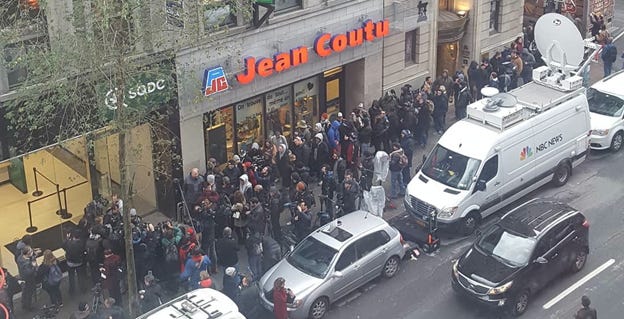
You may be asking the question “if it is government revenue, then how can it be benefiting the black market?” If you find this paradoxical, then this series will be most useful to you.
The reality is that the global business of drugs has always been controlled by the CIA, City of London, Gladio and the Vatican since WWII with the Mafia as their servants to the cause. In other words, drug profits have predominantly always gone to fund terrorist activity, the secret armies of NATO (aka Gladio), fascist dictatorships and their police states, the black budget and parallel states all for their envisioned New World Order.
The FBN Myth On the “War on Drugs” Crusade
“What cannot now be denied is that US intelligence agencies arranged for the release from prison of the world’s preeminent drug lord [Lucky Luciano], allowed him to rebuild his narcotics empire, watched the flow of drugs into the largely black ghettoes of New York and Washington, D.C., escalate and then lied about what they had done. This founding saga of the relationship between American spies and gangsters set patterns that would be replicated from Laos and Burma to Marseilles and Panama.”
- Alexander Cockburn and Jeffrey St. Clair, Whiteout: The CIA, Drugs, and the Press
The beginning of what would be the modern-day opioid pushers would come out of the American presence in Asia during WWII. Recall that the original opioid pushers in the 19th century and earlier were the British East India Company, who destroyed India’s textiles so they could not compete with Britain’s cotton industry and turned India into a British colony and an opioid producer (this is also what justified the cotton slave plantations in the American South). This was followed by Britain claiming its right to forcefully sell said opium to China as per their “free market” rules and fought two Opium Wars with China, taking possession of Hong Kong and Shanghai in the process. (Hence the opium dealing bank HSBC, Hong Kong Shanghai Banking Corporation, being a City of London bank).
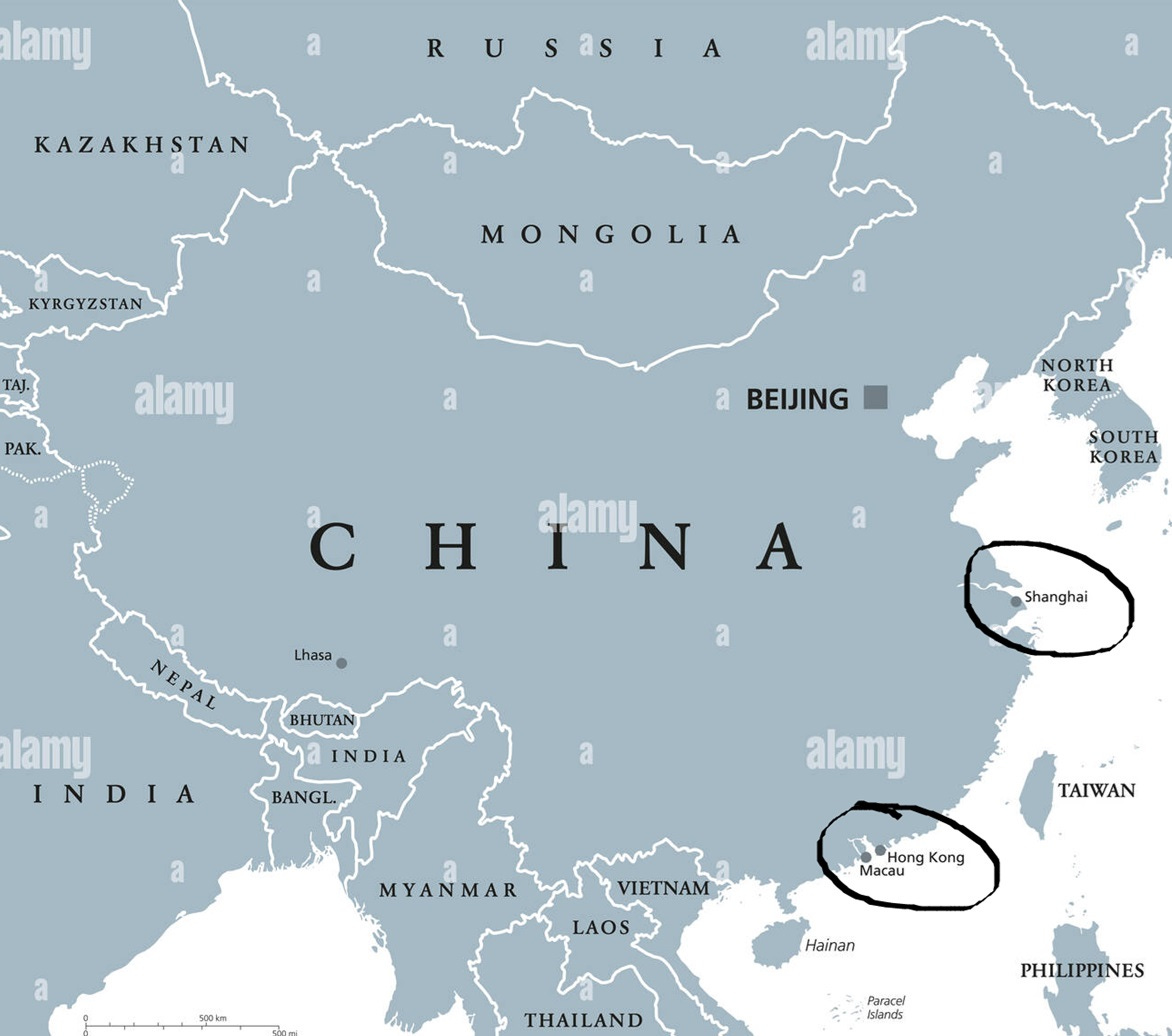
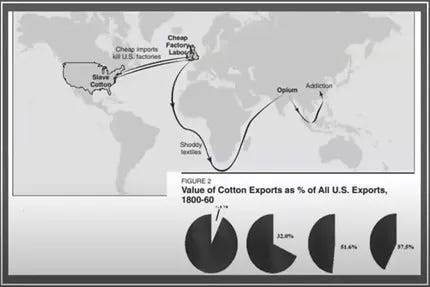
Amazingly, this very fact is being used against China. With unsound minds using the zero-sum deranged logic - that certainly with such abuses China suffered in the past it must desire revenge with its new-found power and influence and thus the current opioid crisis must be just that, China’s revenge for our past sins! No need to look any further. Nevermind the fact that the City of London still exists, and that such opioid dealing banks like HSBC are stronger than ever and have been caught recently building the opioid crisis coming out of Mexico among other places throughout the world.
HSBC has reserved the right to this day, the authority to print 1/3 of Hong Kong currency, the only other two allowed agencies being Standard Chartered Bank (another British multinational bank with headquarters in the City of London) and Bank of China, the only Chinese owned bank. Thus, China has the authority to only print 1/3 of Hong Kong currency even though Hong Kong is legally recognised as part of China. And this despite HSBC being on a blacklist of foreign companies in China.
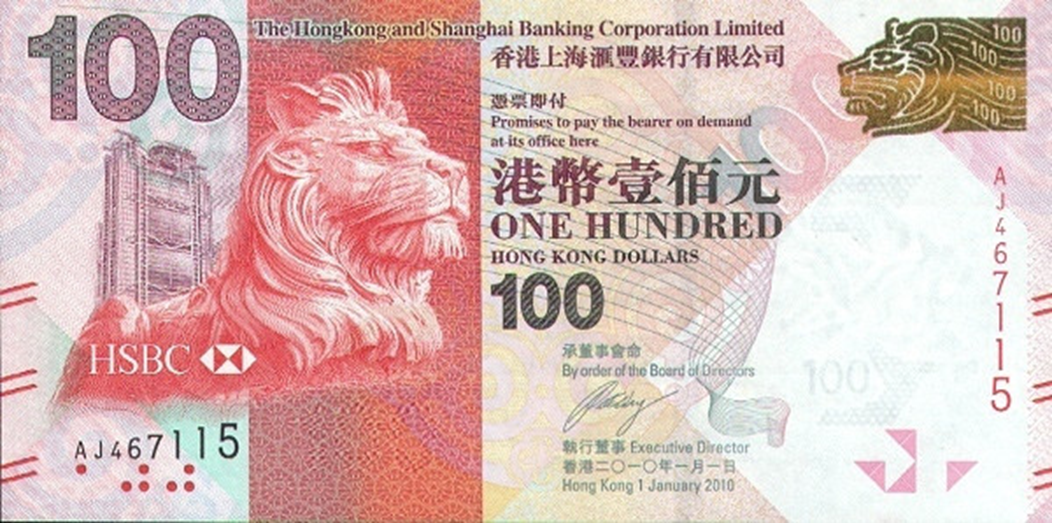
Does this not strike the reader as extremely convenient? Hong Kong is a center for the notorious Triad gang and have been responsible for a significant portion of the opioid influx into the United States, however, who is the Triad gang in service to? As we can see from just scratching on the surface a little, it is clear that China, who only recently had Hong Kong returned to them in 1997 (before that Hong Kong was a British colony for 99 years) does not to this day have full authority over what occurs in Hong Kong as seen very clearly from the fact that two British banks have authority to print 2/3 of the Hong Kong currency, a currency that is in Hong Kong Dollars rather than in the Chinese Yuan. And that both of these British banks, but especially HSBC, have been implicated numerous times on very serious charges of opioid trafficking, in fact HSBC was created for that very purpose after the Opium Wars when Britain took possession of Hong Kong and Shanghai hence the name “Hong Kong Shanghai Banking Corporation.”
However, most westerners are not aware of these details. They hear the words “Hong Kong”, and “Triads” and think thus this must be an organic Chinese phenomenon that is backed by communist government of China, the PRC. The reality is, that after the British heavy-handed introduction of opioid production and consumerism in India and China, the Americans took up the helm during the period of WWII of opioid trafficking in East Asia which they then almost immediately brought into Latin America. Note, the City of London has continued its original investments in the opioid market, the Americans just basically took over the “dirty work” for British interests.
So how did the Americans get caught up in this mess that would result in American soldiers dying for a hill in Vietnam?
Before this can be answered, we need to do a little history review of China in order to clarify some things for readers who may not know very much about the political dynamics that were occurring in East Asia during this time.
Peter Dale Scott writes in his foreword to Henrik Kruger’s book “The Great Heroin Coup”:[2]
“As for the American scene, it may be difficult on first reading to accept his [Kruger’s] hypothesis of a huge ‘Miami conspiracy’, now ‘reaching out with a vengeance to Latin America’…Other observers of the so-called ‘Fascist international’ phenomenon (to use the term first given respectability by Le Monde), have seen it as more polycentric…But…there is unquestioningly increasing international unity among the professional terrorists…from Argentine AAA to the World Anti-Communist Leage (WACL) founded by KMT intelligence personnel on Taiwan.
Before World War II the KMT [Kuomintang] regime in China was perhaps the best example of political manipulation of the narcotics traffic, under the guise of an ‘opium suppression campaign,’ to finance both a political and an intelligence apparatus (under General Tai Li). This practice spread after World War II to a number of other WACL member countries and groups.
Today [1980] there is cause to fear that Nixon’s superagency, the Drug Enforcement Administration, has, like other narcotics enforcement agencies before it, come to use corrupt personnel who are actually part of the traffic, as part of a covert war against revolution.”
When Peter Dale Scott is referring to Taiwan as pivotal to the narcotics trafficking, the reader should be aware that China had fought a 22-year-long civil war, namely the communist forces of Mao Zedong against the Kuomintang (KMT) army of General Chiang Kai-shek (August 1927-1949), which overlapped the Second Sino-Japanese War (1937-1945) where the Chinese also fought against Japanese fascists for their very existence. This second war with the Japanese fascists as the invaders into China, started before WWII began and only ended once the Japanese were defeated by the Russian allies.
Where many European nations wouldn’t last longer than two weeks against the Nazi forces, China had successfully fought a decades long war that it was entirely at a disadvantage in against the Japanese war machine while simultaneously fighting a civil war with the American backed army of Chiang Kai-shek and managed to save their country from foreign balkanization. Chiang Kai-shek, who would continue to be backed by the OSS and later the CIA, retreated his KMT army and a number of his followers to the island of Taiwan once he lost the civil war.
Taiwan was by this time mostly inhabited by Chinese merchants and fishermen who had travelled from the mainland centuries ago, other than the natives who had been living there for several centuries (and who also had experienced a brutal tyranny from a Japanese occupation on the island). The Japanese had left Taiwan after losing the war, and Chiang filled that vacuum. Chiang was known for avoiding a direct confrontation with the Japanese fascists during the civil war, to the frustration of members of the US military, such as General Stilwell and General Wedemeyer who viewed their mission as fighting the Japanese fascists not aiding Chiang in defeating his political enemies, and the Americans were uneasy about the looming potential for an alliance between Chiang and the Japanese that could take hold if the wind were to blow in the right direction.
Taiwan and the KMT (Kuomintang) were under Chiang’s rule until he died in 1975. Thus, when researchers make the distinction that Taiwan was responsible for narcotics trafficking one needs to understand that this was not sanctioned by the Chinese communists, nor by the Chinese government of mainland China, but rather the Taiwanese government of Chiang Kai-shek.
However, Chiang never considered his government rule, effectively a military dictatorship, in Taiwan as separate from China. In other words, Chiang continued to believe until his dying breath, that he was the sole legitimate leader of the Republic of China and he fought for this recognition internationally, i.e. Chiang felt his island government should rule all of China, including the mainland.
In 1971, this matter was brought forward to the United Nations to put a vote as to which government they would recognise as the government of China: the ROC (Republic of China), Chiang’s government; or the PRC (People’s Republic of China), the Chinese communist government of mainland China. The UN members voted to recognise the PRC. The ROC maintained its claim of being the sole legitimate representative of China and its territory until 1991, when it ceased to regard the Chinese Communist Party as a rebellious group and acknowledged the PRC as the legitimate government of mainland China.[3]
Since Taiwan did not want to give up its identity as being Chinese, they were recognised as effectively, a part of China after the UN vote. Again, the Taiwanese people are Han Chinese people who speak mandarin and grew up with Chinese culture, traditions and value systems (pre-communism). Thus, most Taiwanese people also identify as Chinese and regard the Chinese who live on mainland China as their people, most Taiwanese have family and friends who live on the mainland.
Since Taiwan refused to be regarded as a government that was not Chinese, the ROC was in a sort of political limbo, since internationally the PRC was now officially recognised as the representative of the Chinese government. And thus, it was only a matter of time, if the Taiwanese wanted to continue their identity as Chinese, that they would have to reconcile with the PRC government of mainland China, though there continue to be radical hold-outs.
However, until 1991, the ROC was operating as a fully separate government to the PRC. And this bears a great deal of weight when reviewing the narcotics trafficking that was coming out of Taiwan under Chiang’s government. This also explains why the World Anti-Communist Leage (WACL) which was founded by the Kuomintang intelligence personnel in Taiwan was at the center of the trafficking, again clearly indicating that these drug profits were ultimately going to be used in anti-communist missions. We will see this as a repeating theme, that those implicated in Gladio networks were always the ones who were found organizing and profiting from drug trafficking in their “justified” cause against communism.
Peter Dale Scott continues:[4]
“The US government’s narcotics Mafia connection goes back, as is well known, to World War II. Two controversial joint operations between OSS (Office of Strategic Services) and ONI (US naval intelligence) established contact (via Lucky Luciano) with the Sicilian Mafia; and (via Tai Li) with the dope-dealing Green Gang of Tu Yueh-Sheng in Shanghai. Both connections were extended into the post-war period as the Luciano and KMT networks slowly resumed their pre-war contacts.”
Yes, the Sicilian Mafia under Luciano was working with the Kuomintang of Chiang Kai-shek in narcotics trafficking, who were brought together by American Intelligence agencies. Both the Sicilian Mafia and the KMT were ultimately working under the purview of the Americans.
Operating under the innocuous title of “Director, Bureau of Investigation and Statistics,” Tai Li (who worked for Chiang) was actually the chief of a combined secret police and intelligence organization said to control over 300,000 agents throughout China and in every foreign nation where Chinese communities existed – from Bangkok to Saigon to San Francisco. General Tai, according to one OSS report, was “not the Admiral Canaris of China, but the Heinrich Himmler.”[5]
Tai Li was also the “completely trusted subordinate, and guardian, of the Generalissimo [Chiang], subject only to the Generalissimo’s orders.”…Their friendship went back to the 1920 when Tai Li had joined the Chinese Communist Party to spy for Chiang, his military mentor. The Generalissimo then turned against his Communist allies, and Tai Li was assigned the task of persecuting his former comrades, many were tortured and killed. The general acquired the services of an underworld group of Shanghai hoodlums, the “Green Gang,” who specialized in kidnapping and extortion, and gave them official respectability as the foundation for his secret police organization.[6]
Scott writes:[7]
“Meanwhile, in the United States, KMT agents helped establish a powerful China Lobby, and collaborated with friends in US agencies to target, and in some cases drive from government, old foes of the former US-KMT-Tai Li alliance including those inside the OSS. A scholarly book in 1960 noted that ‘the narcotics business has been a factor in some activities and permutations of the China Lobby,’ thus challenging the official Narcotics Bureau myth that KMT dope in this country was ‘Communist Chinese.’
The Luciano and KMT networks had been in contact for US dope distribution in the 1930s. Although there is no evidence of substantial collaboration between them in the 1950s, there are symptoms of increasing convergence, partly through agents who dealt with both. There is the example of George White, an FBN [Federal Bureau of Narcotics] official and former OSS agent who testified to the Kefauver Committee that he had been approached on behalf of Luciano in 1943 by an old China trafficker, August del Grazio. White worked closely with the CIA in the post-war years and (under FBN cover) ran one of their LSD experiments in Project MK/ULTRA.
…Under the oversight of Ferri-Pisani and the Guerini gang, Corsican traffickers worked with the Luciano network and in the 1950s were its chief source of refined heroin.
…Although White worked on the Luciano and Corsican cases, his FBN reputation had been made in 1937 by smashing a major distribution network headed by the pro-KMT Chinese tong (gang) in San Francisco, the Hip Sings. But by 1951 the CIA was closely allied with KMT drug operations in Burma and Yunnan, through a Miami based proprietary, Sea Supply, Inc., organized by OSS veteran Paul Helliwell.
In 1959 the FBN and White again arrested a new generation of Hip Sing officials, but only after the ringleader (Chung Wing Fong, a former Hip Sing president and official of the San Francisco Chinese Anti-Communist League, a KMT front) had yielded his passport to the US consul in Hong Kong and then travelled as ordered to Taiwan. In this way Fong became no more than an unindicted conspirator and the KMT disappeared from view; White, meanwhile, turned around and told the US press the heroin came from Communist China…”
The reader should note here that White was also implicated, as an FBN agent, in actually running an LSD experiment for the illegal CIA Project MK/ULTRA. Thus, White does not sound like he is ultimately working to get rid of the drug epidemic, as he was directly involved in studying actual effects in drug-induced mind control experiments. Rather, it appears that there was a territorial dispute over the global drug trade, a big factor in what led up to the Vietnam War. In 1959, there was already American presence in Vietnam, the Saigon Military Mission began in January 1954.[8]
As we will see, the Corsican Mafia and the KMT were ultimately squeezed out as the Americans took over full control. However, they still did not wish for the KMT role to be exposed, for the KMT were still political useful as a pivot to China, as well as the fact that exposing the KMT would ultimately expose the CIA, since all trails would lead in the end to American Intelligence.
Peter Dale Scott continues:[9]
“In 1953-1954 the CIA drew on old China hands [i.e. OSS men who worked in China] with exposure to KMT traffic (Chennault, William Pawley, Howard Hunt) to set up the overthrow of the Arbenz government in Guatemala, an operation which at least contemplated the use of ‘Puerto Rican and Cuban gangsters.’ As part of this operation, we see CIA officer Howard Hunt, a veteran with his friend Lucien Conein and Conein’s friend WerBell of OSS operations in China under Helliwell, helping in 1954 to set up what would eventually become the Latin American branch of the KMT-backed World Anti-Communist Leage. Four years later the chairman of this group was the Guatemalan attorney of New Orleans Mafia leader Carlos Marcello.”
Thus, the very year that the Saigon Military Mission would begin in Vietnam, was the same year that they established their pipeline into Latin America to start funneling in drugs from the Corsican-KMT-CIA production line in East Asia.
The Corsican Mafia had achieved a monopoly on the production chain of premium heroin. Lucien Conein, who was very familiar with the Corsican heroin activity in East Asia, would be instrumental in aiding the Americans, by betraying the Corsicans, in seizing control of these heroin channels coming out of East Asia while in Vietnam. This was a large reason for the need for American soldiers in Vietnam. This was later all part of Nixon’s so-called “War on Drugs” which was just to concretize the take-over of opium trafficking channels and production facilities from the Corsicans and KMT, essentially cutting out the middle-men.[10] However, throughout the 1950s and 1960s the Corsicans and KMT worked hand-in-hand with the CIA, as did the Mafia, the drug profits largely going towards “anti-communist” causes, i.e. Gladio.
As Peter Dale Scott acknowledges, the role of Communist China in drug trafficking is an FBN myth. The research of Douglas Valentine also corroborates this observation.
Valentine writes in “The Strength of the World”:[11]
“The flaw in Anslinger’s theory [Harry J. Anslinger, 1st Commissioner of the Federal Bureau of Narcotics] of a communist drug conspiracy was revealed in August 1955. In testimony before the Daniel Committee, Anslinger had said that Kuomintang troops were not growing opium in Burma, and that Thailand was likewise uninvolved in the drug trade. But one week later, Thailand’s prime minister fired police chief Phao Sriyanond for awarding himself (in his dual role as finance minister) a $1 million reward for having seized twenty tons of opium on the Thai-Burma border. Shocked that an official would do such a thing, US Ambassador John Peurifoy criticized Phao and urged the Thai military to take over drug law enforcement. Seeking vindication, Phao revealed that the seized opium belonged to the Kuomintang.
…
Reporter Darrell Berrigan expanded [on this]…in an extraordinary article in the May 1956 Saturday Evening Post. Flying in the face of Anslinger’s propaganda, Berrigan reported that Taiwanese businessmen financed the drug trade in Bangkok in league with South Vietnamese generals [recall at this time Vietnam had been broken into North and South with South Vietnam being anti-communist]. He traced the $70 million-a-year business to the 1947 truce between Thailand’s police chief and General Sarit Thanarat. ‘By accident of history,’ Berrigan wrote, ‘the middlemen between Yunnan and Thailand are…3,000 KMT troops who turned over the famous 20 tons in the summer of 1955.’ Berrigan tied the KMT to an international ring, with ships and planes, as well as secret airfields in Laos, and the CIA.
Anslinger was quoted in Berrigan’s article as saying that the PRC was smuggling half-ton loads of opium to South Vietnam. But Anslinger had studiously ignored the fact that Thailand had an opium monopoly, an opium processing plant, and fifty tons of opium in its larder. He also ignored the fact that the CIA was facilitating Thailand’s drug business through the Sea Supply Corporation, a Miami-based CIA proprietary formed, with the legal assistance of former OSS officer Paul Helliwell, to advise the Thai police and clandestinely provide arms to KMT troops spread along the Thai-Burma border.
Paul Helliwell is the personification of the CIA’s respectable, financial aspect of international drug trafficking. While serving as an Army intelligence officer in the Middle East in the Second World War, he was drafted by Wiliam Donovan to manage OSS Special Intelligence operations in China. In that sensitive position, Helliwell worked with Chiang Kai-shek’s intelligence chief, General Tai Li, and through him the drug smuggling Green Gang in Shanghai. Under his direction, OSS officers also employed opium as a weapon of political warfare.
…
After serving as chief of a Strategic Services Unit in the Far East, Helliwell joined a Miami law firm in 1947. A specialist in private financing, he helped set up the CIA proprietary companies Civil Air Transport (later renamed Air America) and Sea Supply in Thailand, and in 1952 became general counsel to Sea Supply and the Thai Consulate in Miami. A mover and shaker in the Florida Republican Party, Helliwell reportedly helped Thai officials invest their drug profits in Florida land deals through Miami’s National Bank and Lou Chesler’s General Development Corporation, and at the same time Meyer Lansky and the Kuomintang were doing likewise.
Anslinger knew this…”
In the early seventies the opium bankrollers in Taiwan sent out, through their international lobby, the WACL[12], propaganda charging Red China with “the drugging of the world.” The propaganda was directed at Nixon’s rapprochement with mainland China. A 1972 BNDD report stated, however, that “not one investigation into heroin traffic in the area in the past two year indicates Chinese communist involvement.”[13]
Valentine continues in “The Strength of the Wolf”:[14]
“Functioning in a similar capacity in Panama was the ubiquitous World Commerce Corporation, the ‘commercially oriented espionage net’ formed by ardent Republican William Donovan and British spymaster William Stephenson. In Honduras, Richard Greenlee, a member of Donovan’s law firm and a former OSS officer in Bangkok, set up Vanguard Services in 1962 as a front for yet another batch of CIA-financed, drug-related anti-Castro operations.”
Noticing a pattern?
Thus, Helliwell would provide covert assistance to the KMT during WWII which included the creation of shipping companies and even banks to facilitate the trafficking of narcotics. Helliwell had become, with the blessing of the OSS crew Bill Donovan, James Angleton and Allen Dulles, along with William Stephenson (aka the Intrepid), master spy of the British Security Coordination, ‘the man who controlled the pipe line of covert funds for secret operations throughout Asia.’[15] The money for this operation would ‘come from Nazi gold that had been laundered and manipulated by Dulles and Stephenson through the World Commerce Corporation, a financial firm established by Will Bill.’[16]
Paul L. Williams writes in “Operation Gladio: The Unholy Alliance between the Vatican, the CIA, and the Mafia”:[17]
“Within Kunming, a town within the South China province of Yunnan…General Chiang Kai-shek, leader of the Kuomintang (KMT – the Chinese National Army), sold opium to Chinese addicts in order to raise funds for his army’s planned war against the Communist forces of Mao Zedong.
…
By the close of World War II, Helliwell and a number of fellow Army intelligence officers – E. Howard Hunt, of Watergate fame; Lucien Conein, a former member of the French Foreign Legion with strong ties to the Corsican Mafia; Tommy ‘the Cork’ Corcoran, a lawyer serving the Strategic Service Unit; and Lt. General Claire L. Chennault, the military advisor to Chiang Kai-shek and the founder of the Flying Tigers – had created the Civil Air Transport (CAT) from surplus aircraft, including C-47 Dakotas and C-46 Commandos.
The CAT fleet transported weapons to a contingency force of the KMT in Burma. The planes were then loaded with drugs for their return trip to China [who was undergoing a civil war during this period]. The pilots who flew these bush-type aircraft were a motley crew of men…Some were former Nazis…Helliwell and his compatriots had created a model for trafficking drugs that would result in the formation of Air America – the CIA fleet of planes that transported opiates and cocaine during and after the Vietnam Conflict. Thanks to their efforts, Burma’s Shan Plateau would grow from a relatively minor poppy-cultivating area into the largest opium producing region of the world.”
Chiang would offer “three sticky brown bars” to Burmese addicts who could offer information about the military plans of Chairman Mao.[18]
It should be evident at this point that the Golden Triangle was a product of the KMT, OSS/CIA.
The Golden Triangle has been one of the largest opium-producing areas of the world since the 1950s. Most of the world's heroin came from the Golden Triangle until the early 21st century when opium production in Afghanistan increased. Myanmar was the world's second-largest source of opium after Afghanistan up to 2022, producing some 25% of the world's opium, forming part of the Golden Triangle. While opium poppy cultivation in Myanmar had declined year-on-year since 2015, cultivation area increased by 33% totalling 40,100 ha (99,000 acres) alongside an 88% increase in yield potential to 790 t (780 long tons; 870 short tons) in 2022 according to latest data from the United Nations Office on Drugs and Crime (UNODC) Myanmar Opium Survey 2022.[19]
General Claire Chennault’s “Flying Tigers” would play a central role in the Golden Triangle operation. The “Flying Tigers” was a group of volunteer airmen who had been recruited, supplied, and financed before Pearl Harbor with unofficial Washington support. Their commander was General Claire Chennault, who had resigned from the American Army in 1937 to become Chiang Kai-shek’s air force advisor.
Chennault’s wife was Anna Chen Chennault, who would become the head of the China Lobby (i.e. KMT Taiwan Lobby under Chiang Kai-shek), which was the key to Southeast Asian opium. ‘Another key figure in the China Lobby was weapons dealer/financier William Pawley, the American cofounder of Chennault’s Flying Tigers. Pawley’s name was the password to intrigue: OSS China, Tommy Corcoran, CIA cover firms, and arms shipments to KMT Chinese on Taiwan in defiance of a State Department refusal of authorization.’[20]
British writer Frank Robertson wrote in 1977:
“Taiwan is a major link in the Far East narcotics route, and a heroin producer. Much of the acetic anhydride – the chemical necessary for the transformation of morphine into heroin -smuggled into Hong Kong and Thailand, comes from this island, a dictatorship under the iron rule of the late Chiang Kai-shek’s son, Chiang Ching-kuo.”[21]
Henrik Kruger writes in “The Great Heroin Coup” (1980):
“The junction of Burma, Thailand, and Laos, the Golden Triangle, is the site of the bulk of the world’s opium production and thereby the source of enormous fortunes for the French and later the Americans. The French held effective control over the Southeast Asian opium traffic until 1965. Between 1946 and 1955 the Mixed Airborne Commando Group (MACG) and the French Air Force managed the shipment of opium from Burma to Laos. A guerilla corps comprised mostly of Laotian Meo tribesmen and led by Colonel Roger Trinquier, MACG remained unusually independent despite its direct connections to the SDECE and Deuxieme Bureau. To finance their secret Indochina operations, these organization turned to the smuggling of gold and opium, with MACG in charge of the latter. Large quantities of opium were shipped to French Saigon headquarters and passed on to the Corsican Mafia, who in turn smuggled the drug to Marseilles.
In 1955 CIA agent General Edward Lansdale began a war to liquidate the Corsican supply network. While Lansdale was cracking down on the French infrastructure, his employer the CIA was running proprietaries, like Sea Supply and CAT, that worked hand-in-hand with the opium-smuggling Nationalist Chinese [Chiang Kai-shek KMT] of the Golden Triangle, and with the corrupt Thai border police.”
Paul L. Williams writes in “Operation Gladio: The Unholy Alliance between the Vatican, the CIA, and the Mafia”:[22]
“Unlike the Sicilian branch of the Mafia, the Corsican Mafia had gained mastery of this process through years of working among Cambodian, Laotian, and Vietnamese technicians in French Indochina. In 1949, the CIA and the Luciano syndicate sorely needed the talents of the Corsicans for the creation of a new narcotics network. But the labor unions in Marseilles, where the heroin laboratories were located, remained controlled by Communists, who refused to load and unload ships coming from French Indochina, where the rebel army of the Democratic Republic of Vietnam [North Vietnam]…was fighting for independence from the French Union. Ho Chi Minh, the leader of the rebels had helped found the French Communists Party and was a popular hero in France among leftist workers, especially in Marseilles with its high number of Indochinese residents.
On February 3, 1947, the Communist-Socialist labor coalition (Confederation Generale du travail) convened a meeting of the Marseilles dock workers that resulted in the publication of a manifesto demanding all unions launch ‘the most effective means possible against the way in Vietnam’ – a strike. The plans to transform the French port city of Marseilles into the center of the heroin industry came to a screeching halt.
To break the strike, Lucky Luciano made contact with Antoine and Barthelemy Guerini, the leaders of the Corsican Mafia, who initiated a series of attacks against the strikers and labor leaders. The attacks, funded by the CIA, continued until 1950, when the Guerinis finally gained complete control of the waterfront.
…
Thanks to the CIA’s assistance, Marseilles now became the new center of the heroin industry. By 1951, only months after the Corsican and Sicilian Mafias took control of the waterfront, the Guerinis recruited a host of French chemists and opened their first opium refineries.
The French connection to the Sicilian clan of Don Calo and the American crime family of Lucky Luciano had been established.”
This explains the enthusiastic fervour that would come from CIA asset Henry Luce’s Time Magazine, which incessantly promoted Chiang as a hero of his people to Americans who had no clue what was really going on in East Asia at the time.
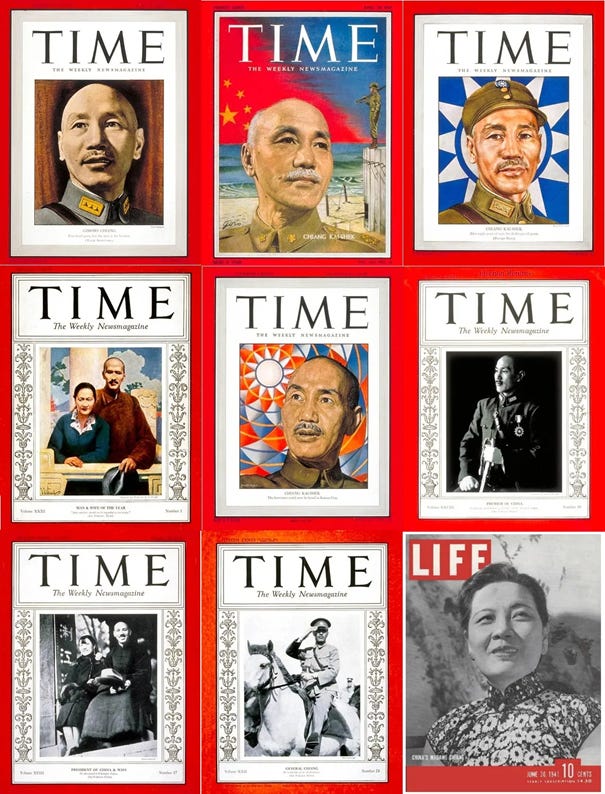
The Triad gang that has become notorious worldwide as a Chinese gang implicated in global drug trafficking works for these very channels, thus has nothing to do with the PRC government of mainland China. The Triads, along with the Green Gang, are splinter groups that can trace back their origins to secret societies that go as far back as the 18th and 19th century.
In 1949, the People’s Republic of China (PRC) made a proclamation that all secret societies in mainland China be suppressed. This campaign against secret societies was launched by Mao Zedong. As a result, most Chinese secret societies, including the Triads and the Green Gang relocated to Hong Kong (a British colony at the time), Taiwan (under Chiang’s rule), Macau (a Portuguese stronghold) and other parts of Southeast Asia, as well as overseas, particularly in the United States (it should be clear by now why that happened). The Triads were never based in a region that was under the control of the PRC.
The KMT had already developed a relationship with the Green Gang early on and during the Republican era (1912-1949), that is, the rule of the ROC on mainland China before Chiang’s retreat to Taiwan, the KMT was enlisting the Triads to assassinate political opponents and attack political enemies.[23] In 1927, the Green Gang participated in the Shanghai massacre, led by Chiang Kai-shek, against Chinese Communist Party (CCP) members in 1927.[24]
It should be clear at this point, the ugly truth, that the communists were in fact never responsible for the global drug trafficking racket but rather the very opposite, they waged war against it. As seen by the actions of the PRC as well as Castro in Cuba, who forced Meyer Lansky’s drug empire to leave Cuba.
There was a lot of money that was lost for big business with Castro’s takeover, not just for Lansky’s Syndicate but for such Fortune 500 names as the United Fruit Company, U.S. Steel, DuPont and Standard Oil, among many others, which tells you something about the real sort of business these companies are involved in.[25] The ugly truth is that the anti-communist cause, the Gladio Crusader mission with support by such groups as the WACL, were in fact the creators and facilitators of this drug epidemic.
Today, opioid pushing banks like HSBC are still operating on a massive scale. In the summer of 2012, the U.S. Senate investigative panel released its 339-page report[26] on HSBC’s work with Mexican narco-gangs and its role in terrorist financing. The Justice Department and HSBC reached their deferred-prosecution agreement at the end of that year. In December 2012, HSBC was penalised $1.9 billion (USD), the largest fine under the Bank Secrecy Act, for violating four U.S. laws designed to protect the U.S. financial system.[27] HSBC had allegedly laundered at least $881 million in drugs proceeds through the U.S. financial system for international cartels, as well as processing an additional $660 million for banks in U.S. sanctioned countries. According to the report, “The U.S. bank subsidiary [also] failed to monitor more than $670 billion in wire transfers and more than $9.4 billion in purchases of physical dollars from its Mexico unit.”[28]
During the prosecution trial, HSBC acknowledged that for years it had ignored warning signs that drug cartels in Mexico were using its branches to launder millions of dollars. A December 2012 CNNMoney article compared the 1.9 billion dollars fine to HSBC's profit “last year” (in 2011) of 16.8 billion.[29]
Leopoldo Barroso, a former HSBC anti-money-laundering director, told company officials in an exit interview that he was concerned about civil and criminal sanctions and that there were “allegations of 60 percent to 70 percent of laundered proceeds in Mexico” going through HSBC’s affiliate, according to the U.S. Senate report.[30]
As we can see by the mammoth activities of just one City of London bank, HSBC, much of the drug problem in Mexico can be clearly seen to be supported by the same old corridors from almost two centuries ago that began with the two Opium Wars that were waged against China for the British East India Company’s right to sell opium to the Chinese people. These corridors have remained intact throughout time and have been profiting off of drug trafficking amongst other things for centuries.
Not only are American and other western intelligence agencies, along with the higher echelons of the DEA and FBN among others, implicated in all of this, with democratically elected governments overthrown in Europe, Asia, and Latin America who dared disagree with such practices, but the very Vatican as well, through the Vatican Bank with the Mafia as its servants, have played a central role in the dealing of drugs globally in order to fund its anti-communist Gladio Crusade.
However, looking at these actions over the past 85 years and more, we should see clearly that it was never truly about a war on communism, it was a war on anyone who would disagree with their view for a New World Order. Let us remember that in this never-ending Cold War saga, even leaders such as John F. Kennedy and Charles de Gaulle were accused of being “communist stooges.” They were accused of this because they dared to seek peace through diplomacy and common understanding rather than clandestine warfare, i.e. permanent warfare. And those today who now ask for dialogue and diplomacy are again attacked as not having the best interest of their nation at heart. Where are we to draw the line?
Let us remember the words of Kennedy, in 1957 on the Senate floor, two days before America’s own Independence Day, Kennedy declared:
“The most powerful single force in the world today is neither communism nor capitalism, neither the H-bomb nor the guided missile – it is man’s eternal desire to be free and independent. The great enemy of that tremendous force of freedom is called, for want of a more precise term, imperialism – and today that means Soviet imperialism and, whether we like it or not, and though they are not to be equated, Western imperialism. Thus, the single most important test of American foreign policy today is how we meet the challenge of imperialism, what we do to further man’s desire to be free. On this test more than any other, this nation shall be critically judged by the uncommitted millions in Asia and Africa, and anxiously watched by the still hopeful lovers of freedom behind the Iron Curtain. If we fail to meet the challenge of either Soviet or Western imperialism, then no amount of foreign aid, no aggrandizement of armaments, no new pacts or doctrines or high-level conferences can prevent further setbacks to our course and to our security.”[31]
In September 1960, the annual United Nations General Assembly was being held in New York. Castro and a fifty-member delegation were among the attendees and had made a splash in the headlines when he decided to stay at the Hotel Theresa in Harlem after the midtown Shelburne Hotel demanded a $20,000 security deposit. He made an even bigger splash in the headlines when he made a speech at this hotel, discussing the issue of equality in the United States while in Harlem, one of the poorest boroughs in the country.
Kennedy would visit this very same hotel a short while after and also made a speech:
“Behind the fact of Castro coming to this hotel, [and] Khrushchev…there is another great traveler in the world, and that is the travel of a world revolution, a world in turmoil…We should be glad [that Castro and Khrushchev] came to the United States. We should not fear the twentieth century, for the worldwide revolution which we see all around us is part of the original American Revolution.”[32]
What did Kennedy mean by this? The American Revolution was fought for freedom, freedom from the rule of monarchy and imperialism in favour of national sovereignty. What Kennedy was stating, was that this was the very oppression that the rest of the world wished to shake off, and that the United States had an opportunity to be a leader in the cause for the independence of all nations.
And so there you have it, the ugly truth. The question is – are we brave enough to face it?
For the role of the Vatican in this story see my paper “Sex, Drugs and the Vatican: The Origin of America’s Drug Epidemic: How Heroin was Flooded into Black Ghettoes to Profit the Gladio Terrorist Network & the Vatican Bank”
Cynthia Chung is the President of the Rising Tide Foundation and author of the books “The Shaping of a World Religion” & “The Empire on Which the Black Sun Never Set,” consider supporting her work by making a donation and subscribing to her substack page Through A Glass Darkly.
Also watch for free our RTF Docu-Series “Escaping Calypso’s Island: A Journey Out of Our Green Delusion” and our CP Docu-Series “The Hidden Hand Behind UFOs”.
Footnotes:
[1] There are several documentaries on the situation of East Hasting, Vancouver which has gained a notoriety worldwide.
[2] Foreword by Peter Dale Scott to Henrik Kruger’s book The Great Heroin Coup (1980), pg. 13
[3] Han Cheung (25 April 2021). "Taiwan in Time: The 'communist rebellion' finally ends". Taipei Times. Archived from the original on 22 October 2021. "...Most importantly, with the repeal of the temporary provisions, the Chinese Communist Party would no longer be seen as a rebel group. "From now on, we will see the Chinese Communist Party as a political entity that controls the mainland region and we will call them the 'mainland authorities' or the 'Chinese Communist authorities'," President Lee said during the press conference"
[4] Foreword by Peter Dale Scott to Henrik Kruger’s book The Great Heroin Coup (1980), pg. 13-16
[5] Richard Harris Smith. OSS: the secret history of America’s first central intelligence agency. Pg. 243
[6] Ibid, pg. 245
[7] Foreword by Peter Dale Scott to Henrik Kruger’s book The Great Heroin Coup (1980), pg. 13-16
[8] It should be noted here that although NSC and Department of State records show that the Saigon Military Mission did not begin until January 1954, there were other CIA activities in Vietnam, Cambodia, and Laos, such as the White Cloud teams, long before 1954, and some members of the SMM had participated in these earlier activities as far back as 1945. Source: Col Fletcher Prouty (1992) JFK: The CIA, Vietnam, and the Plot to Assassinate John F. Kennedy. Birch Lane Press Book, pg. 61.
[9] Foreword by Peter Dale Scott to Henrik Kruger’s book The Great Heroin Coup (1980), pg. 16
[10] The Vietnam War was officially fought between 1955-1975, Nixon’s presidency lasted from 1969-1974.
[11] Douglas Valentine. Strength of the Wolf (2018). Pg. 158-160
[12] Spearheading WACL’s Latin America drive is the Confederation Anticommunista Latinoamericana (CAL), which is connected to the Federacion Mexicana Anticommunista (FEMACO). Fianncial support for these organizations is allegedly supplied through Shuen Shigh Kao, a Mexico-based agent of Taiwan intelligence – see P. Chairoff: Dossier Neo-Nazisme 1978. WACL’s tolerant attitude towards heroin smuggling was never more evident than in the case of Chao Sopsaisana, who in 1977 was arrested in Paris with sixty kilos of pure heroin in his valise. Diplomatic immunity got him back to Laos, where he continued in his role as vice president of the National Assembly as if nothing had happened. He remains today the president of the Laotian chapter of WACL. Source Kruger.
[13] Kruger, pg. 152
[14] Ibid pg 271-272
[15] Martin A. Lee. The Beast Awakens: Fascism’s Resurgence from Hitler’s Spymasters to Today’s Neo Nazi Groups and Right Wing Extremists. Pg. 18-19.
[16] Paul L. Wiliams. Operation Gladio: The Unholy Alliance between the Vatican, the CIA, and the Mafia (2018). Pg. 31
[17] Ibid
[18] Ibid, pg. 32
[19] Source: Wikipedia. https://en.wikipedia.org/wiki/Golden_Triangle_(Southeast_Asia)
[20] Henrik Kruger. The Great Heroin Coup: Drugs, Intelligence and International Fascism (1980). Pg. 131
[21] Ibid, pg. 132
[22] Paul L. Williams. Operation Gladio. Pg. 51-52
[23] Ramzy, Austin (2019-07-24). "What Are the Triads, and What Is Their History of Violence?"
[24] Ibid.
[25] Talbot, David. (2015) The Devil’s Chessboard: Allen Dulles, the CIA, and the Rise of America’s Secret Government. Harper New York, pg. 459.
[26] Hearing before the Permanent Subcommittee on Investigations of the Committee on Homeland Security and Governmental Affairs United States Senate. (July 17, 2012) U.S. Vulnerabilities to Money Laundering, Drugs, and Terrorist Financing: HSBC Case Study. https://web.archive.org/web/2/https://www.govinfo.gov/content/pkg/CHRG-112shrg76061/html/CHRG-112shrg76061.htm.
[27] Mollenkamp, Carrick; Wolf, Brett (December 11, 2012). HSBC to pay record $1.9-billion fine in U.S. money-laundering case. Reuters. https://www.reuters.com/article/uk-hsbc-probe-idUKBRE8BA05K20121211. Retrieved October 2022.
[28] Ibid
[29] O’Toole, James. (December 12, 2012) HSBC: Too big to jail? CNNMoney. https://money.cnn.com/2012/12/12/news/companies/hsbc-money-laundering/. Retrieved October 2022.
[30] Hearing before the Permanent Subcommittee on Investigations of the Committee on Homeland Security and Governmental Affairs United States Senate. (July 17, 2012) U.S. Vulnerabilities to Money Laundering, Drugs, and Terrorist Financing: HSBC Case Study. https://web.archive.org/web/2/https://www.govinfo.gov/content/pkg/CHRG-112shrg76061/html/CHRG-112shrg76061.htm.
[31] Talbot, David. (2016) The Devil's Chessboard: Allen Dulles, the CIA, and the Rise of America's Secret Government. Harper Perennial, pg. 305
[32] Ibid. pg. 295




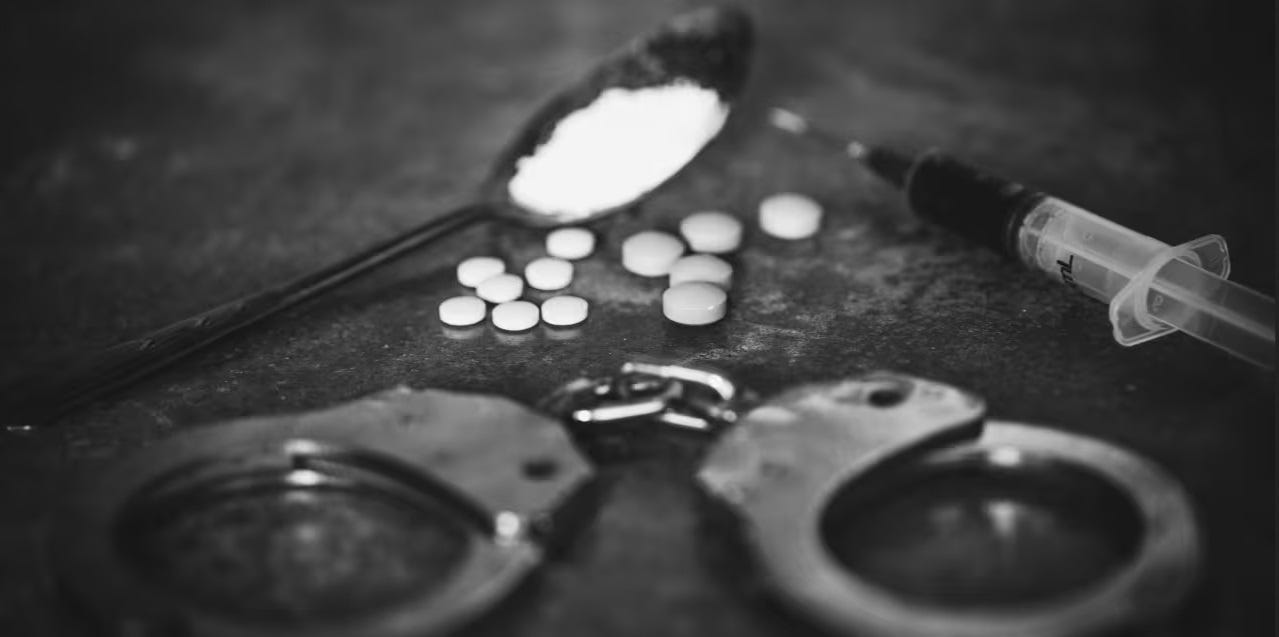
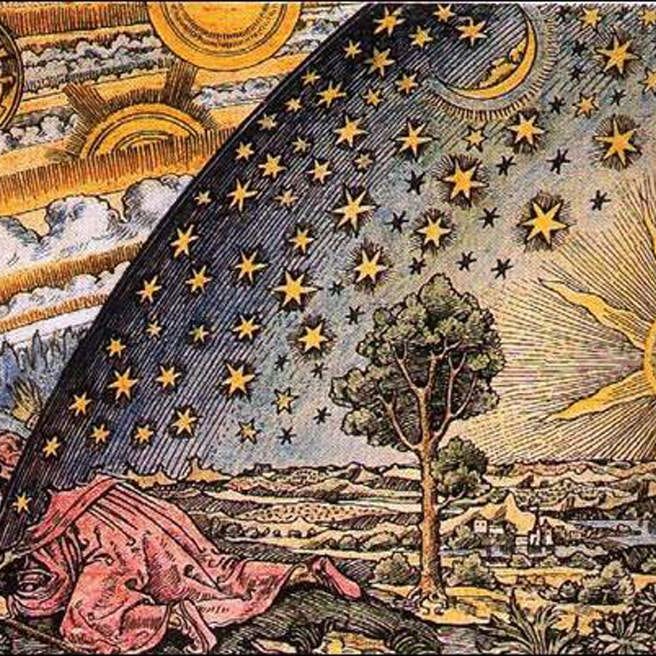
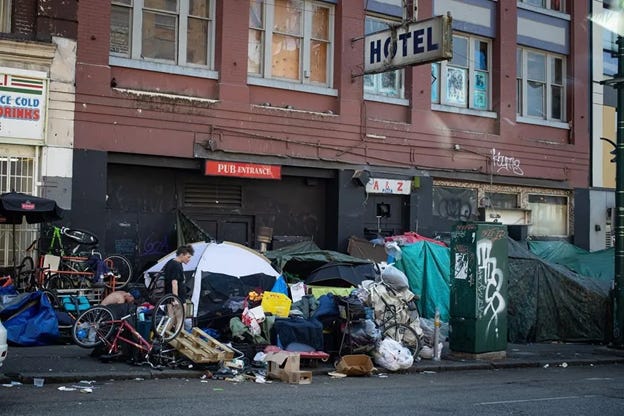
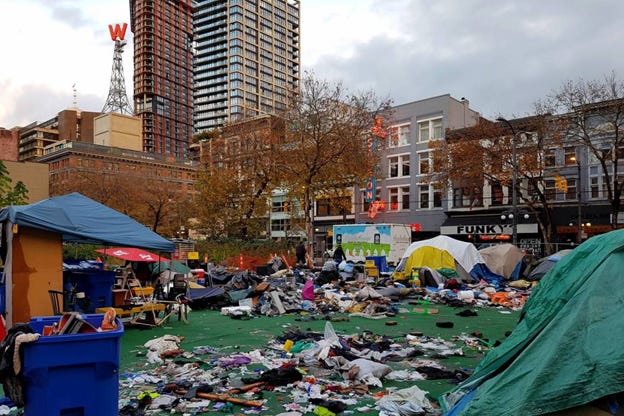
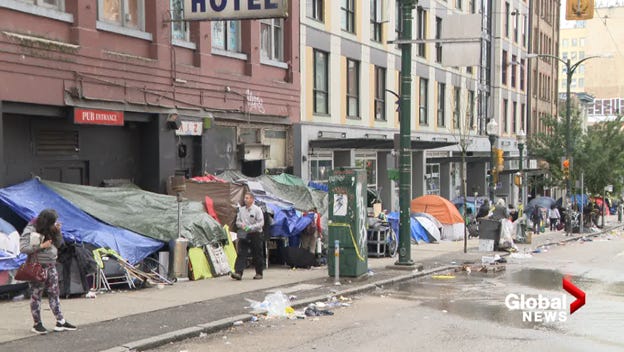
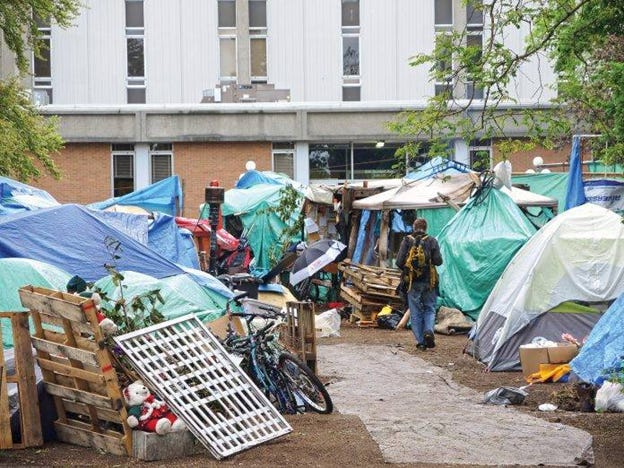
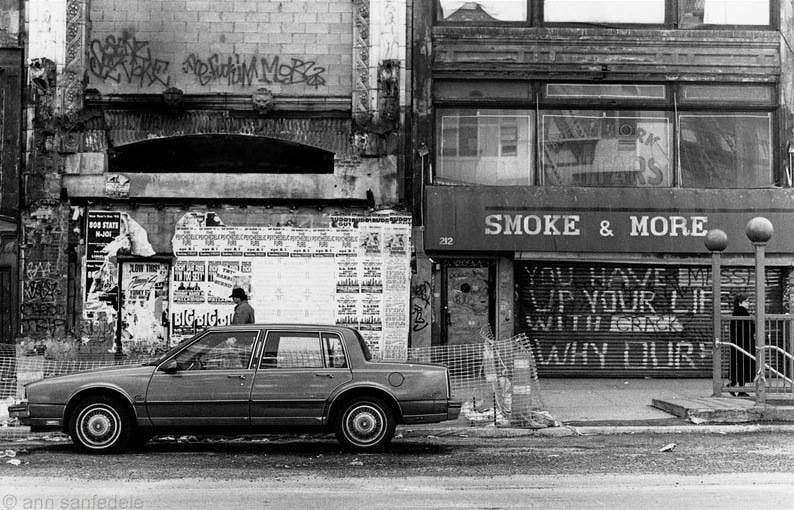
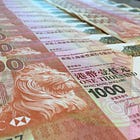
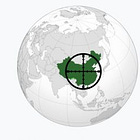
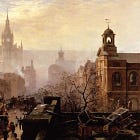
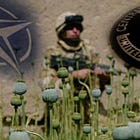
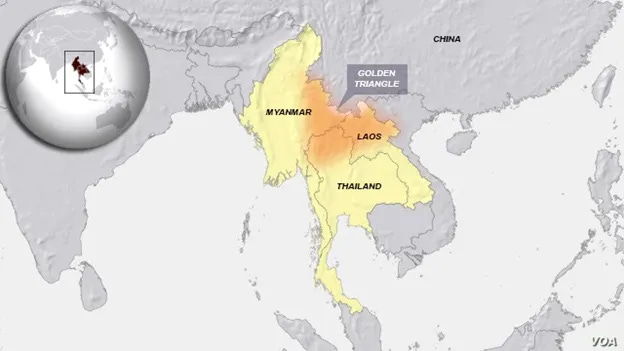
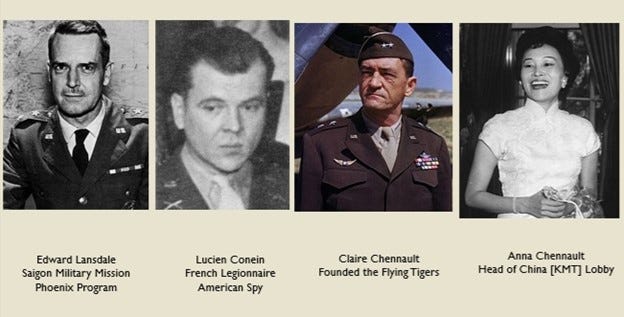



You are such a brilliant researcher and writer, Cynthia. I learn so much from you. I'm going to be using the phrase 'mushy liberal,' which captures the phenomenon of empty sentimentality without running the numbers on how policies play out. My town of Santa Cruz has the highest ratio of homeless to residents in California, and California has the highest ratio in the country. So it's a problem of mushy thinking I encounter daily and my economic model looks at how to change it with five years when transients (including students) go back to where they were born or have family now, where the community has the tools to strengthen families, who then have financial incentives to help their own members.
I've wondered how fentanyl figures in, which I think has been a CIA plot against street drugs, including home growers now that it's legal. But I also has included some pharma products that I talk about here: https://thirdparadigm.substack.com/p/opioids-and-the-new-opium-war.
And finally, do you know the Kuang series on The Poppy War? I did an episode on that and Fadi Lama's book Why the West Can't Win, only realizing in the process they were about the same event. The horror of Manchukuo is something I can't believe I got this far in life and never knew about. Here's that episode and thank you again for this deep and elucidating information: https://thirdparadigm.substack.com/p/poppy-wars-and-manchukuo-monsters.
SDECE - French secret service (1945-82), now DGSE. great references and very informative to see that post-WW2 smuggling, trafficking and war-mongering networks had their tentacles going back in time to pre-war years. fascinating to read how these could grow into a 'secret' (well, not so secret) worldwide Empire built on unbridled violence, greed and extortion. absolutely horrifying.